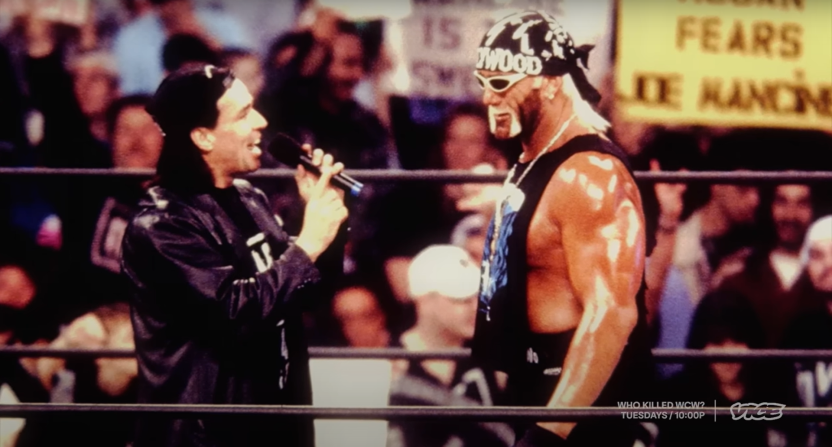Vice TV’s Who Killed WCW? docuseries doesn’t wait long to get to the good stuff.
The opening scene of the four-part series’ premiere episode (which can be viewed here) features never-before-seen backstage footage from the final episode of WCW Monday Night Nitro. While behind-the-scenes pro wrestling footage is nothing new in 2024, that wasn’t the case in 2001. And even two decades later, it remains jarring to see the uncertainty that surrounded the monumental show.
Unfortunately for viewers, that’s as good as the series gets.
While the announcement of Who Killed WCW?, produced by Dwayne “The Rock” Johnson’s Seven Bucks Productions and the creators of Vice TV’s Dark Side of the Ring series, was met with plenty of fanfare, the docuseries ultimately proved as disappointing as the subject it was covering. The premise of the series centers on answering the rhetorical question asked in its title, even though there were obviously several factors that led to WCW’s demise more than two decades ago.
Rather than critically examining such factors from a neutral viewpoint, Who Killed WCW? allows each party to tell its side of the story, with most — if not all — unsurprisingly deflecting blame. If there’s a main character in the four-part series, it’s Eric Bischoff, the former WCW president whose creative direction both bolstered and helped submarine the pro wrestling promotion.
Both the highs and lows of Bischoff’s WCW tenure are explored, but often through his unchecked perspective. Rather than having any pro wrestling journalists — many of whom have been critical of Bischoff over the years — on the show as de facto fact-checkers, the show relies on Guy Evans, the author of the great NITRO: The Incredible Rise and Inevitable Collapse of Ted Turner’s WCW book, to largely further the show’s story arc.
It’s worth noting that Evans is the co-author of Bischoff’s 2022 autobiography and has a seemingly friendly relationship with the former WCW president. Bischoff has also heavily covered, if not co-promoted, Who Killed WCW? on his personal YouTube page.
That’s not to say there weren’t voices on the show — especially former wrestlers, who had their own personal narratives to further — that were critical of Bischoff. But none had the ability to combat his attempts to deflect blame, from both business and creative standpoints, as effectively as somebody who covers the business for a living likely would have been able to do.
“It was very much an image rehab on Bischoff,” longtime wrestling journalist Dave Meltzer said on Thursday’s episode of Wrestling Observer Radio. “Almost to the — well, I don’t want to get into conspiracy theories. It’s not really fair.”
It is fair, however, to wonder why Bischoff was painted in such a positive light when his creative decisions — some of which he was even willing to criticize — played such a strong role in destroying WCW’s popularity and value to Turner Broadcasting, who the show points one of its biggest fingers at.
That’s not to say that Bischoff is the only person deserving of blame. Far from it. But it was more than curious to see the second episode end with him sympathetically staring into the Wyoming mountains and the finale include a scene in which he emotionally watches a clip of Kevin Nash — who also played a not insignificant role in WCW’s demise — praising his accomplishments.
As for why Who Killed WCW? didn’t include any traditional journalists, producer Evan Husney told POST Wrestling that it came down to a “creative preference.” He also stated that he thinks that a lot of the “newsletter reporters” (a thinly veiled reference to Meltzer) haven’t been able to remain objective on the matter and that he relied on Evans — who again, recently wrote a book with Bischoff — to remain an objective voice.
But what might have served the series creative clearly came at a cost journalistically, which was a sentiment shared by many viewers of the show.
The other problem with Who Killed WCW? is that despite its best efforts, it doesn’t cover much that hasn’t already been covered extensively before.
The first three episodes of the series largely focus on WCW’s backstory, which is already well established lore for pro wrestling fans. After rehashing the formation of the nWo, the “Finger Poke of Doom,” Vince Russo’s arrival and David Arquette winning the world title, the fourth episode focuses on WCW’s final days and WWF’s controversial purchase of the promotion.
Nitro footage aside, this is where the series was at its best, gaining access to former Turner president Brad Siegel and then-WWF president Stu Snyder, who were key figures in the deal. Keeping in line with its overarching narrative, the show heavily implies that Siegel and Snyder colluded to make the deal that proved to be WCW’s death sentence — a theory that seemingly has some merit, but wasn’t fully dissected.
Perhaps a journalist would have helped?
All things considered, the series reaches the conclusion that there were many factors that went into WCW’s demise, but casts a particularly jaundiced eye at Turner for eschewing a deal to sell the company to Bischoff in favor of the controversial agreement with WWF. The series, however, fails to fully examine why Turner didn’t want to remain in business with Bischoff, who is treated just as much as a victim as a suspect in the story.
Unfortunately, not even the nostalgia of late-1990s pro wrestling is enough to overcome the series’ seemingly slanted story. In its apparent attempt to avoid the alleged biases of reporters, the series leaned into its least objective figures, creating a chaotic and ego-soaked experience all too familiar for former WCW viewers.
